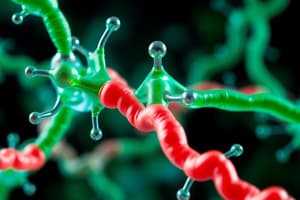Podcast
Questions and Answers
What effect does a competitive inhibitor have on the Km value of an enzyme?
What effect does a competitive inhibitor have on the Km value of an enzyme?
- Km value remains unchanged
- Km value increases (correct)
- Km value is not relevant to competitive inhibition
- Km value decreases
Which of the following statements is true regarding non-competitive inhibitors?
Which of the following statements is true regarding non-competitive inhibitors?
- They can be outcompeted by increasing substrate concentration.
- They have a structural resemblance to the substrate.
- They bind to the active site of the enzyme.
- They do not affect the Km value of the enzyme. (correct)
What happens to Vmax in the presence of a competitive inhibitor?
What happens to Vmax in the presence of a competitive inhibitor?
- Vmax is not affected by substrate concentration
- Vmax remains unchanged (correct)
- Vmax increases
- Vmax decreases
Which medication serves as an antidote for heavy metal poisoning through non-competitive inhibition?
Which medication serves as an antidote for heavy metal poisoning through non-competitive inhibition?
What is a characteristic of competitive inhibitors?
What is a characteristic of competitive inhibitors?
What does a high Km value indicate about an enzyme's affinity for its substrate?
What does a high Km value indicate about an enzyme's affinity for its substrate?
What is the purpose of a Lineweaver-Burk plot?
What is the purpose of a Lineweaver-Burk plot?
Which type of inhibitor competes with the substrate for the active site?
Which type of inhibitor competes with the substrate for the active site?
What characteristic does a non-competitive inhibitor have?
What characteristic does a non-competitive inhibitor have?
Which of the following is true about irreversible inhibitors?
Which of the following is true about irreversible inhibitors?
What is the role of enzymes in chemical reactions?
What is the role of enzymes in chemical reactions?
Which factor does NOT affect enzyme activity?
Which factor does NOT affect enzyme activity?
What is the meaning of 'Km' in the Michaelis-Menten Equation?
What is the meaning of 'Km' in the Michaelis-Menten Equation?
How does allosteric regulation affect enzyme activity?
How does allosteric regulation affect enzyme activity?
What happens to proenzymes to activate them?
What happens to proenzymes to activate them?
Which of the following best describes the enzyme-substrate complex (ES)?
Which of the following best describes the enzyme-substrate complex (ES)?
What is a consequence of covalent modification of an enzyme?
What is a consequence of covalent modification of an enzyme?
What is the primary purpose of the Michaelis-Menten model?
What is the primary purpose of the Michaelis-Menten model?
What is the primary action of uncompetitive inhibitors?
What is the primary action of uncompetitive inhibitors?
How do uncompetitive inhibitors affect Vmax and Km?
How do uncompetitive inhibitors affect Vmax and Km?
What characterizes irreversible inhibitors?
What characterizes irreversible inhibitors?
What is the outcome of irreversible inhibition in terms of enzyme kinetics?
What is the outcome of irreversible inhibition in terms of enzyme kinetics?
What role does acetylcholinesterase (AChE) play in the nervous system?
What role does acetylcholinesterase (AChE) play in the nervous system?
Which of the following is NOT a type of cholinesterase mentioned?
Which of the following is NOT a type of cholinesterase mentioned?
Inhibition by organophosphates is classified as which type of inhibition?
Inhibition by organophosphates is classified as which type of inhibition?
What happens to acetylcholine after it is hydrolyzed by acetylcholinesterase?
What happens to acetylcholine after it is hydrolyzed by acetylcholinesterase?
Flashcards are hidden until you start studying
Study Notes
Enzymes
- Enzymes are specific molecules that act on one or few types of molecules (substrates) to create a molecular product.
- They are biological catalysts, capable of accelerating chemical reactions without being part of the final products or being consumed in the process.
- The binding of a substrate forces the enzyme to change conformation (like oxygen binding to hemoglobin).
- This change decreases the energy of activation needed to transition the substrate into an unstable state.
- This allows the reaction to proceed and form a product, regenerating the enzyme.
Enzyme Regulation
- Covalent modification: Enzymes are regulated by adding or removing chemical groups, often through phosphorylation.
- Allosteric regulation/Feedback inhibition: The end product of a metabolic reaction can inhibit the first or regulatory enzyme in the sequence if it is in excess.
- Proenzymes: These are inactive forms of enzymes that can be activated by removing a small part of their polypeptide chain.
Factors Affecting Enzyme Activity
- pH
- Temperature
- Substrate concentration
- Enzyme concentration
- The presence of inhibitors or activators
Michaelis-Menten Hypothesis
- This model describes an enzyme reversibly combining with its substrate to form an ES (enzyme-substrate) complex, which then forms a product and regenerates the free enzyme.
- Variables:
- [E]: free enzyme molecules
- [S]: free substrate molecules
- [ES]: enzyme-substrate complexes
- [P]: free product molecules
- Parameters:
- kf, kr, kcat: reaction rates
Michaelis-Menten Equation
- Describes how the reaction velocity varies with [S].
- Potency (Km): Reflects the enzyme's affinity to the substrate.
- High Km: low affinity
- Low Km: high affinity
- Velocity of the reaction: Proportional to enzyme concentration when [S] is not limiting.
Lineweaver-Burk Plot
- This plot is a double reciprocal plot that changes the hyperbolic curve of the Michaelis-Menten model into a straight line.
- The intercept on the x-axis is -1/Km and the intercept on the y-axis is 1/Vmax.
Enzyme Inhibitors
- Molecules or factors that interact with enzymes and prevent them from working.
- Nonspecific Inhibitors: Affect all enzymes in the same way (e.g., acids, alcohol).
- Specific Inhibitors: Exert their effects on a specific enzyme.
- Reversible: Inhibitor can dissociate from the enzyme and catalytic activity is regained.
- Competitive: Resemble the enzyme's substrate and compete for the active site.
- Non-competitive: Do not resemble the substrate, bind to a different site and cause conformational changes in the enzyme.
- Uncompetitive: Bind only to the ES complex.
- Irreversible: Inhibitor combines with the functional groups of the amino acids in the active site irreversibly.
- Reversible: Inhibitor can dissociate from the enzyme and catalytic activity is regained.
Competitive Inhibition
- The inhibitor is structurally similar to the substrate.
- The inhibitor binds to the active site, competing with the substrate.
- Increased substrate concentration can overcome inhibition.
- Km increases: Affinity of the enzyme to the substrate is decreased.
- Vmax remains unchanged: Increasing [S] displaces the inhibitor and allows the reaction to reach Vmax.
Competitive Inhibition: Statins
- Clinically useful competitive inhibitors like statins (drugs used to lower cholesterol) are examples of this type of inhibition.
Non-competitive Inhibition
- Inhibitor binds to a site other than the active site.
- Inhibitor has no structural resemblance to the substrate.
- Increasing substrate concentration does not relieve inhibition.
- Reaction is slowed down but not halted.
- Km value is unchanged.
- Vmax decreases.
Non-competitive Inhibition: Clinical Examples
- BAL (British Anti-lewisite): Used as an antidote for heavy metal poisoning.
- Heavy metals act as enzyme poisons by reacting with SH groups.
- BAL has several SH groups that react with the heavy metal ions, reducing their poisonous effects.
Uncompetitive Inhibition
- Inhibitor binds only to the ES complex, not the free enzyme.
- The enzyme becomes catalytically inactive.
- Inhibition cannot be reversed by increasing substrate concentration.
- Decrease in both Vmax and Km.
- Example: Placental alkaline phosphatase (ALP) inhibited by phenylalanine.
Irreversible Inhibition
- Inhibitor binds very tightly to the enzyme, usually through covalent or non-covalent bonds, forming a very stable complex.
- Inhibition is considered irreversible because the inhibitor dissociates very slowly from the enzyme complex.
- Examples: Organophosphates (OP) poisoning and oxidizing agents.
Irreversible Inhibition: Kinetics
- Similar to non-competitive inhibition in terms of kinetics:
- Vmax decreased
- Km unchanged
Cholinesterases
- Enzymes involved in the proper functioning of the nervous system in humans, vertebrates, and insects.
- Function: Break down acetylcholine into choline and acetic acid.
- Role in nerve transmission: Signals carried by acetylcholine are terminated by acetylcholinesterase (AChE). This prevents the neuron from remaining in an activated state.
Types of Cholinesterases
- Acetylcholinesterase (AChE): Most common type, also known as cholinesterase I or erythrocyte cholinesterase.
- Found in neural synapses, neuromuscular junctions, central nervous system, and red blood cell membranes.
Studying That Suits You
Use AI to generate personalized quizzes and flashcards to suit your learning preferences.



